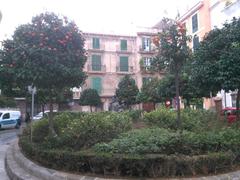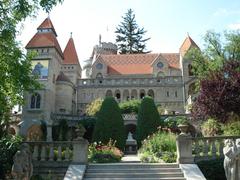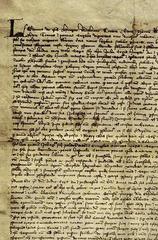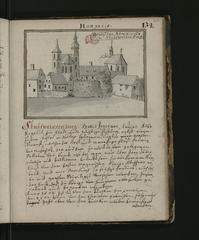
Comprehensive Guide to Visiting Székesfehérvár, Székesfehérvár District, Hungary
Date: 14/08/2024
Captivating Introduction
Welcome to Székesfehérvár, a city where history and magic intertwine, offering a captivating journey through time and beauty. Imagine traversing the cobblestone streets of one of Hungary’s oldest cities, where every stone whispers tales of kings, battles, and rebirths. Székesfehérvár, often referred to as Hungary’s first capital, is more than just a destination; it’s a living, breathing museum that showcases the rich tapestry of Hungarian history. From its Roman origins as Herculea to its pivotal role in the medieval era under King Stephen I, Székesfehérvár has been a cornerstone of Hungarian culture and politics (Britannica, Wikipedia).
Step into the grandeur of the Székesfehérvár Basilica, a Romanesque marvel where 43 Hungarian kings were crowned and 15 were buried. Feel the echoes of the Golden Bull of 1222, Hungary’s own Magna Carta, resonate through the city’s ancient walls. Picture yourself exploring the whimsical Bory Castle, an eclectic architectural masterpiece that stands as a testament to one man’s dream (TideTrips, SpotsCities).
But Székesfehérvár is not just about the past. It’s a city that thrives in the present, bustling with vibrant cultural events like the Royal Days festival, which brings history to life with music, dance, and medieval reenactments (HelloHungary). Whether you’re wandering through the serene Kings’ Park, marveling at the floral beauty of the Székesfehérvári Virágóra, or diving into the rich collections of the King Stephen Museum, Székesfehérvár offers a unique blend of history, culture, and charm that promises to enchant every visitor. So pack your bags and get ready to unlock the secrets of Székesfehérvár, a city where every corner is a new adventure waiting to be discovered.
Table of Contents
- Historical Significance
- Key Attractions
- Visitor Tips for Székesfehérvár, Székesfehérvár District, Hungary
Historical Significance of Székesfehérvár
Early Foundations and Medieval Importance
Imagine stepping into a time machine and traveling back to one of Hungary’s oldest cities, Székesfehérvár. This captivating city, with roots dating back to the Roman era when it was known as Herculea, is like a living history book. Established as a significant settlement by Géza, the Grand Prince of the Hungarians, in 972, Székesfehérvár’s early days were set on four moorland islands between the Gaja stream and its tributary, the Sárvíz, complete with a small stone castle (Britannica).
Under Stephen I of Hungary, the city’s prominence soared. He granted town rights to Székesfehérvár and initiated the construction of the Romanesque Székesfehérvár Basilica between 1003 and 1038. This basilica became the ultimate royal hotspot, serving as the coronation and burial site for Hungarian kings. Picture this: 43 kings crowned and 15 buried here (Wikipedia).
Golden Bull of 1222
Székesfehérvár isn’t just about kings and castles; it played a crucial role in Hungarian constitutional history. In 1222, King András II issued the Golden Bull right here – a document often dubbed Hungary’s Magna Carta. It outlined the rights of nobles and the duties of the king, forming the backbone of Hungary’s constitution until 1848 (Wikipedia).
Ottoman and Habsburg Periods
Székesfehérvár’s strategic importance made it a prime target during the Ottoman-Habsburg wars. The city fell to the Ottomans in 1543 and remained under their control until 1688. Imagine the devastation – the cathedral and palace were looted and demolished. But like a phoenix, Székesfehérvár began its slow recovery once the Ottomans withdrew (Britannica).
In 1703, Székesfehérvár regained its status as a free royal town. The 18th century was a time of revival, with new constructions like the Franciscan church and monastery, Jesuit churches, and Baroque palaces. Maria Theresa elevated the city to an episcopal seat in 1777, adding to its religious and cultural significance (Wikipedia).
Modern Era and World War II
The 20th century was a rollercoaster of development and devastation for Székesfehérvár. The city faced near-total destruction during the last German counterattack in Hungary in 1945. However, post-war efforts helped restore many historical buildings and monuments, preserving its rich heritage for future generations (Britannica).
Architectural and Cultural Heritage
Székesfehérvár is a treasure trove of historical landmarks. The ruins of the medieval cathedral, where many Hungarian kings were crowned, are meticulously preserved. The city also flaunts exquisite Baroque buildings, like the bishop’s palace, along with a variety of museums and galleries that showcase its cultural legacy (Britannica).
Székesfehérvár Basilica
The Székesfehérvár Basilica, with its roots tracing back to the 12th century, stands as the city’s most iconic landmark. This Romanesque-style church was the coronation site for Hungarian kings and houses the ornate tombs of King Stephen I and other royals in its crypt. Currently, the basilica is undergoing renovations to restore its original exterior decorations (TideTrips).
Bory Castle
No visit to Székesfehérvár is complete without exploring Bory Castle, a unique architectural masterpiece built by Hungarian architect and sculptor Jenő Bory in the early 20th century. With its eclectic mix of styles and materials, and surrounded by beautiful gardens, it’s a whimsical wonderland that continues to captivate tourists (SpotsCities).
King Stephen Museum
Dive into Hungary’s past at the King Stephen Museum. Its extensive collection includes medieval weapons, religious art, and archaeological finds, providing visitors with a deep understanding of Székesfehérvár’s storied history (Travopo).
Cultural Events and Festivals
Székesfehérvár is buzzing with cultural events and festivals all year round. One highlight is the Royal Days, centered around the feast of St. Stephen, taking place between August 11 and 20. The festival fills the streets with traditional bands, old-time music ensembles, and stilt-walking comedians, all bringing history to life (HelloHungary).
Visitor Tips
Planning a visit to Székesfehérvár? Spring and fall are the ideal times to explore the city when the weather is mild and pleasant. The city’s well-developed public transportation system, including buses and trams, makes it easy to get around and visit its numerous attractions (Travopo).
Key Attractions
Bory Castle
Imagine a place where Gothic, Romanesque, and Baroque styles unite in a symphony of stone and art. Welcome to Bory Castle, a whimsical fortress crafted over 40 years by the passionate architect and sculptor Jenő Bory. Every corner, mosaic, and sculpture tells a story. Climb the towers for jaw-dropping panoramic views—perfect for that Instagram shot. Bory Castle isn’t just a visit; it’s a visual feast (Veronika’s Adventure).
Saint Stephen’s Cathedral
Step into the grandeur of Saint Stephen’s Cathedral, a Baroque masterpiece built between 1758 and 1768. Designed by the Austrian architect Franz Anton Hillebrandt, this cathedral is a treasure trove of religious artifacts and historical books. It’s like stepping into a time machine that takes you back to Hungary’s regal past (Ibn Battuta Travel).
Székesfehérvári Virágóra (Flower Clock)
A clock that blooms? Yes, please! The Székesfehérvári Virágóra is a delightful floral clock in the city center. With vibrant flowers changing each season, it’s a year-round spectacle. Snap some photos and bask in the tranquil vibes, especially during spring and summer when the blooms are at their finest (Ibn Battuta Travel).
Csók István Képtár (István Csók Gallery)
Art lovers, rejoice! The Csók István Képtár showcases classic 19th and 20th-century artworks, from paintings to stone carvings. The gallery itself is an architectural gem with Scandinavian influences, adorned with beautiful mosaics. It’s a treasure trove of Hungarian artistic heritage (Ibn Battuta Travel).
Kings’ Park
Escape the hustle and bustle at Kings’ Park, a serene natural oasis named after the wooden carvings of Hungarian kings by György Sétih. Perfect for leisurely walks, picnics, and some good old relaxation by the lake. Visit during the warmer months for lush greenery and calm waters—a picture-perfect setting (Ibn Battuta Travel).
King Stephen Museum
Dive into Székesfehérvár’s rich history at the King Stephen Museum. From archaeological finds to royal artifacts, this museum offers an in-depth look at the city’s past, from Roman times to its role as a coronation site. History buffs, this one’s for you! (Ibn Battuta Travel)
Municipal Market
Get a taste of local life at the Municipal Market. Fresh produce, traditional Hungarian clothing, and handicrafts await. It’s a bustling hub where you can sample local delicacies and snag some unique souvenirs (Ibn Battuta Travel).
Cziráky Mansion
Step back in time at Cziráky Mansion, also known as Shiraki Castle. Dating back to the late 15th century, this mansion boasts a grand central hall, ornate Roman columns, and an English garden complete with an artificial lake and waterfall. It’s a haven for photographers and history enthusiasts alike (Ibn Battuta Travel).
Halesz Park
Halesz Park is your go-to spot for outdoor fun. Jogging and cycling paths, playgrounds, and shaded picnic areas make it perfect for families and groups. Enjoy the fresh air and natural beauty of Székesfehérvár in this well-maintained green space (Ibn Battuta Travel).
Visitor Tips for Székesfehérvár, Székesfehérvár District, Hungary
Welcome to Székesfehérvár, Hungary’s best-kept secret, where every stone has a story and every street a saga. Think of Székesfehérvár as Budapest’s whimsical younger sibling—quirky, charming, and brimming with hidden gems waiting to be discovered.
Best Time to Visit
Székesfehérvár is like a chameleon, changing its colors with the seasons. Spring (April to June) and fall (September to October) are the best times to visit, offering mild weather perfect for exploring. Summer (July and August) brings the heat and vibrant festivals, while winter (December to February) offers a quieter, cozy charm with festive Christmas markets. Imagine sipping mulled wine while snowflakes dance around you—pure magic!
Getting Around
This city was built for strolling. The heart of Székesfehérvár is pedestrian-friendly, with many attractions just a stone’s throw away. Fancy a bike ride? Rentals are easy to find, and the city boasts numerous cycling routes. Public transportation is reliable, and buses can whisk you to various nooks and crannies. Mini-Quest: Can you find the hidden statue of the city’s founder? Hint: It’s near the oldest church.
Accommodation
From luxurious hotels to quaint guesthouses, Székesfehérvár has it all. Staying in the city center is a smart move, placing you steps away from the main attractions. Pro tip: Book in advance during peak seasons to snag the best deals.
Dining and Local Cuisine
Prepare your taste buds for a culinary adventure! Traditional Hungarian dishes like goulash and pörkölt are must-tries, and don’t miss the chimney cake—a sweet pastry that will make your mouth water. Picture yourself in a bustling market, the aroma of chimney cakes mingling with the sound of church bells. For a relaxed meal, pop into a local café for coffee and pastries. Street stalls during festivals offer a delightful taste of Hungarian street food culture.
Language and Communication
While Hungarian is the official language, you’ll find English commonly spoken in tourist areas. Learning a few basic phrases can enhance your experience. Pronunciation guide: ‘Köszönöm’ (kuh-sur-num) means ‘Thank you’ and ‘Jó napot’ (yo na-pot) means ‘Good day’. Pro tip: A heartfelt ‘Köszönöm’ with a smile can open doors to warm welcomes.
Currency and Payments
Hungary uses the Hungarian Forint (HUF). Credit cards are widely accepted, but carrying some cash is wise for small purchases. ATMs are plentiful for convenient cash withdrawals.
Local Etiquette
Visiting religious sites? Dress modestly and behave respectfully. Some areas may restrict photography, so look for signs or ask first. Tipping is customary—10-15% for good service is the norm.
Safety Tips
Székesfehérvár is generally safe, but stay vigilant. Keep an eye on your belongings in crowded areas and avoid poorly lit streets at night. Use reputable taxis or public transportation for a safe journey.
Cultural Events and Festivals
Székesfehérvár comes alive with festivals! The Royal Days Festival in August is a highlight, featuring medieval reenactments and honoring Saint Stephen I. The Fehérvári Huszár Napok offers historical pageantry. Wandering through these festivals feels like stepping into a beloved Hungarian epic.
Exploring the Countryside
The countryside around Székesfehérvár is a haven for outdoor enthusiasts. Trails for hiking and cycling range from easy to challenging. Renting a bike lets you explore sunflower fields, vineyards, and charming villages. Electric bikes are available for a more leisurely ride.
Shopping
The city center is a treasure trove of local shops and boutiques. Find unique souvenirs like handmade pottery, embroidered textiles, and local wines. Festivals bring additional vendors selling an array of local products.
Health and Wellness
Relax and rejuvenate in Székesfehérvár’s thermal baths and wellness centers. These facilities often include saunas, steam rooms, and massage services. Check opening hours and book in advance for a seamless experience.
Ready to uncover Székesfehérvár’s secrets? Download Audiala for expert insights and hidden gems that will make your visit unforgettable.
By following these tips, visitors can immerse themselves in Székesfehérvár’s rich history, vibrant culture, and stunning natural beauty.
Conclusion
Székesfehérvár is a city where history lives on in its well-preserved landmarks, rich cultural heritage, and vibrant community events. From the medieval ruins of the Székesfehérvár Basilicato the eclectic Bory Castle, the city offers a unique glimpse into Hungary’s past. Whether you’re a history buff or an adventurous traveler, Székesfehérvár is a must-visit destination. So, what are you waiting for? Dive into history and explore Székesfehérvár today!
Call to Action
As your journey through Székesfehérvár comes to a close, you’ll find that this city leaves an indelible mark on your soul. From the ancient Roman beginnings to its medieval grandeur and beyond, Székesfehérvár is a testament to Hungary’s rich and resilient history. You’ve walked through the ruins of the Székesfehérvár Basilica, where kings were crowned, and explored the whimsical Bory Castle, a unique blend of artistic styles and personal passion (Britannica, TideTrips).
The city’s vibrant cultural events, like the Royal Days, have shown you that Székesfehérvár is not just a relic of the past but a living, breathing community that celebrates its heritage with fervor and joy (HelloHungary). Whether you’ve sampled traditional Hungarian dishes at the Municipal Market or found peace in the serene surroundings of Kings’ Park, Székesfehérvár offers a multifaceted experience that caters to both history buffs and casual travelers alike.
Ready to delve even deeper into Székesfehérvár’s secrets? Download Audiala, your perfect travel companion. With beautifully crafted, concise yet deep audio guides, Audiala unveils the city’s hidden gems and stories, making your exploration even more enriching. Don’t just visit Székesfehérvár—immerse yourself in its history, culture, and charm. Download Audiala now and let the adventure begin!
References
- Székesfehérvár | Hungary | Britannica, 2024, Encyclopaedia Britannica https://www.britannica.com/place/Szekesfehervar
- Székesfehérvár, 2024, Wikipedia https://en.wikipedia.org/wiki/Székesfehérvár
- Things to Do in Székesfehérvár, Hungary, 2024, TideTrips https://tidetrips.com/things-to-do-in-szekesfehervar-hungary/
- Székesfehérvár: Where History and Modernity Unite in the Heart of Hungary, 2024, SpotsCities https://spotscities.com/szekesfehervar-where-history-and-modernity-unite-in-the-heart-of-hungary/
- Székesfehérvár Royal Days 2024, 2024, HelloHungary https://hellohungary.hu/en/culture/szekesfehervar-royal-days-2024
- Székesfehérvár Daytrip: Old Capital of Hungary, 2024, Veronika’s Adventure https://veronikasadventure.com/szekesfehervar-daytrip-old-capital-of-hungary/
- 9 Things to Do in Székesfehérvár, Hungary, 2024, Ibn Battuta Travel https://en.ibnbattutatravel.com/europe/9-things-to-do-in-szekesfehervar-hungary-for-all-ages/
- Székesfehérvár Travel Guide, 2024, Travopo https://travopo.com/travel-guides/hungary/szekesfehervar/





